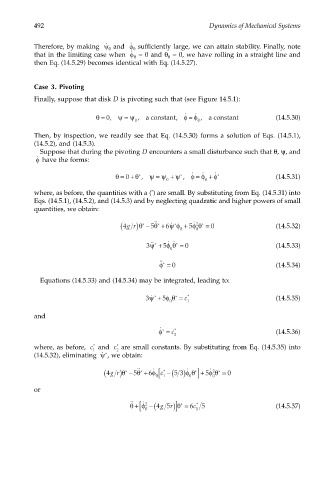Page 511 - Dynamics of Mechanical Systems
P. 511
0593_C14_fm Page 492 Tuesday, May 7, 2002 6:56 AM
492 Dynamics of Mechanical Systems
Therefore, by making ˙ ψ 0 and φ ˙ 0 sufficiently large, we can attain stability. Finally, note
that in the limiting case when φ ˙ 0 = 0 and θ = 0, we have rolling in a straight line and
0
then Eq. (14.5.29) becomes identical with Eq. (14.5.27).
Case 3. Pivoting
Finally, suppose that disk D is pivoting such that (see Figure 14.5.1):
˙
˙
θ = 0, ψ = ψ , a constant, φ φ , a constant (14.5.30)
=
0 0
Then, by inspection, we readily see that Eq. (14.5.30) forms a solution of Eqs. (14.5.1),
(14.5.2), and (14.5.3).
Suppose that during the pivoting D encounters a small disturbance such that θ, ψ, and
φ ˙ have the forms:
˙
θ =+ θ , ψ = ψ + ψ , φ = φ + φ * ˙ (14.5.31)
˙
*
*
0
0 0
where, as before, the quantities with a ( ) are small. By substituting from Eq. (14.5.31) into
*
Eqs. (14.5.1), (14.5.2), and (14.5.3) and by neglecting quadratic and higher powers of small
quantities, we obtain:
( 4gr)θ * − 5θ * ˙˙ + ˙ * 0 + 5φ θ = 0 (14.5.32)
˙
6ψ φ
2 *
0
ψ +
˙ ˙ *
3 ˙˙ * 5φ θ = 0 (14.5.33)
0
˙˙*
φ= 0 (14.5.34)
Equations (14.5.33) and (14.5.34) may be integrated, leading to:
ψ +
3 ˙ * 5φ θ = c * (14.5.35)
*
0 1
and
φ= c * (14.5.36)
˙ *
2
where, as before, c * and c * are small constants. By substituting from Eq. (14.5.35) into
1 2
ψ
(14.5.32), eliminating ˙ * , we obtain:
1 (
( 4gr)θ * − 5θ * ˙˙ + 6φ ˙ 0[ c − 5 3) ] + 5φ θ = 0
˙
φ θ
˙
*
*
2 *
0
0
or
˙˙ θ + [ 0 5 θ )] * = 6c * 1 5 (14.5.37)
˙ 2
φ −(4gr

